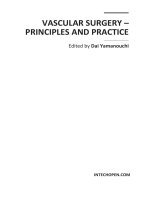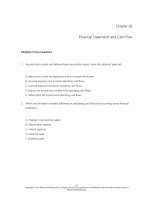Communications receivers principles and design 4th by rohde
Bạn đang xem bản rút gọn của tài liệu. Xem và tải ngay bản đầy đủ của tài liệu tại đây (45.45 MB, 941 trang )
1
2
Copyright©2017byMcGraw-HillEducation.Allrightsreserved.ExceptaspermittedundertheUnited
StatesCopyrightActof1976,nopartofthispublicationmaybereproducedordistributedinanyformor
byanymeans,orstoredinadatabaseorretrievalsystem,withoutthepriorwrittenpermissionofthe
publisher.
ISBN:978-0-07-184334-8
MHID:0-07-184334-5.
ThematerialinthiseBookalsoappearsintheprintversionofthistitle:ISBN:978-0-07-184333-1,
MHID:0-07-184333-7.
eBookconversionbycodeMantra
Version1.0
Alltrademarksaretrademarksoftheirrespectiveowners.Ratherthanputatrademarksymbolafterevery
occurrenceofatrademarkedname,weusenamesinaneditorialfashiononly,andtothebenefitofthe
trademarkowner,withnointentionofinfringementofthetrademark.Wheresuchdesignationsappearin
thisbook,theyhavebeenprintedwithinitialcaps.
McGraw-HillEducationeBooksareavailableatspecialquantitydiscountstouseaspremiumsandsales
promotionsorforuseincorporatetrainingprograms.Tocontactarepresentative,pleasevisittheContact
Uspageatwww.mhprofessional.com.
InformationcontainedinthisworkhasbeenobtainedbyMcGraw-HillEducationfromsourcesbelieved
tobereliable.However,neitherMcGraw-HillEducationnoritsauthorsguaranteetheaccuracyor
completenessofanyinformationpublishedherein,andneitherMcGraw-HillEducationnoritsauthors
shallberesponsibleforanyerrors,omissions,ordamagesarisingoutofuseofthisinformation.This
workispublishedwiththeunderstandingthatMcGraw-HillEducationanditsauthorsaresupplying
informationbutarenotattemptingtorenderengineeringorotherprofessionalservices.Ifsuchservices
arerequired,theassistanceofanappropriateprofessionalshouldbesought.
TERMSOFUSE
ThisisacopyrightedworkandMcGraw-HillEducationanditslicensorsreserveallrightsinandtothe
work.Useofthisworkissubjecttotheseterms.ExceptaspermittedundertheCopyrightActof1976and
therighttostoreandretrieveonecopyofthework,youmaynotdecompile,disassemble,reverse
engineer,reproduce,modify,createderivativeworksbasedupon,transmit,distribute,disseminate,sell,
publishorsublicensetheworkoranypartofitwithoutMcGraw-HillEducation’spriorconsent.Youmay
usetheworkforyourownnoncommercialandpersonaluse;anyotheruseoftheworkisstrictly
prohibited.Yourrighttousetheworkmaybeterminatedifyoufailtocomplywiththeseterms.
THEWORKISPROVIDED“ASIS.”McGRAW-HILLEDUCATIONANDITSLICENSORSMAKE
NOGUARANTEESORWARRANTIESASTOTHEACCURACY,ADEQUACYOR
COMPLETENESSOFORRESULTSTOBEOBTAINEDFROMUSINGTHEWORK,INCLUDING
ANYINFORMATIONTHATCANBEACCESSEDTHROUGHTHEWORKVIAHYPERLINKOR
OTHERWISE,ANDEXPRESSLYDISCLAIMANYWARRANTY,EXPRESSORIMPLIED,
INCLUDINGBUTNOTLIMITEDTOIMPLIEDWARRANTIESOFMERCHANTABILITYOR
3
FITNESSFORAPARTICULARPURPOSE.McGraw-HillEducationanditslicensorsdonotwarrantor
guaranteethatthefunctionscontainedintheworkwillmeetyourrequirementsorthatitsoperationwillbe
uninterruptedorerrorfree.NeitherMcGraw-HillEducationnoritslicensorsshallbeliabletoyouor
anyoneelseforanyinaccuracy,errororomission,regardlessofcause,intheworkorforanydamages
resultingtherefrom.McGraw-HillEducationhasnoresponsibilityforthecontentofanyinformation
accessedthroughthework.UndernocircumstancesshallMcGraw-HillEducationand/oritslicensorsbe
liableforanyindirect,incidental,special,punitive,consequentialorsimilardamagesthatresultfromthe
useoforinabilitytousethework,evenifanyofthemhasbeenadvisedofthepossibilityofsuch
damages.Thislimitationofliabilityshallapplytoanyclaimorcausewhatsoeverwhethersuchclaimor
causearisesincontract,tortorotherwise.
4
Contents
Preface
AbouttheAuthors
1BasicRadioConsiderations
1.1Introduction
1.1.1SDR,Defined
1.2RadioSystemFrontiers
1.2.15GFundamentals
1.2.2LookingAhead
1.3RadioCommunicationsSystems
1.3.1RadioTransmissionandNoise
1.4Modulation
1.4.1AnalogModulation
1.4.2ModulationforDigitalSignals
1.5DigitalSignalProcessing
1.5.1Analog-to-Digital(A/D)Conversion
1.5.2Digital-to-Analog(D/A)Conversion
1.5.3ConverterPerformanceCriteria
1.5.4ProcessingSignalSequences
1.5.5DigitalFilters
1.5.6NonlinearProcesses
1.5.7DecimationandInterpolation
1.5.8DSPHardwareandDevelopmentTools
1.6RadioReceiverArchitectures
1.6.1Super-RegenerativeReceivers
1.7TypicalRadioReceivers
1.7.1AnalogReceiverDesign
1.7.2Mixed-ModeMFSKCommunicationSystem
1.7.3PLLCADSimulation
1.7.4Software-DefinedRadioSystems
1.7.5DesignExample:EB500MonitoringReceiver
1.8References
1.9Bibliography
1.10SuggestedAdditionalReading
2RadioReceiverCharacteristics
2.1Introduction
5
2.2TheRadioChannel
2.2.1ChannelImpulseResponse
2.2.2DopplerEffect
2.2.3TransferFunction
2.2.4TimeResponseofChannelImpulseResponseandTransferFunction
2.3RadioSystemImplementation
2.3.1InputCharacteristics
2.3.2Gain,Sensitivity,andNoiseFigure
2.4Selectivity
2.5DynamicRange
2.5.1Desensitization
2.5.2AMCrossModulation
2.5.3IM
2.6ReciprocalMixing
2.6.1PhaseErrors
2.6.2ErrorVectorMagnitude
2.7SpuriousOutputs
2.8GainControl
2.9BFO
2.10OutputCharacteristics
2.10.1BasebandResponseandNoise
2.10.2HarmonicDistortion
2.10.3IMDistortion
2.10.4TransientResponse
2.11FrequencyAccuracyandStability
2.12FrequencySettlingTime
2.13ElectromagneticInterference
2.14DigitalReceiverCharacteristics
2.14.1BERTesting
2.14.2TransmissionandReceptionQuality
2.15References
2.16Bibliography
2.17SuggestedAdditionalReading
3ReceiverSystemPlanning
3.1TheReceiverLevelPlan
3.2CalculationofNF
3.2.1NoiseFactorforCascadedCircuits
3.3NoiseCorrelationinLinearTwoPortsUsingCorrelationMatrices
3.3.1NoiseFigureTestEquipment
3.3.2HowtoDeterminetheNoiseParameters
3.4Linearity
3.4.1DynamicRange,Compression,andIMO
3.4.2Analysis
6
3.5CalculationofIP
3.5.1ExampleofNFandIPCalculation
3.6SpuriousResponseLocations
3.6.1D-HTraces
3.7Selectivity
3.7.1Single-TunedCircuit
3.7.2CoupledResonantPairs
3.8ComplexFilterCharacteristics
3.8.1ButterworthSelectivity
3.8.2ChebyshevSelectivity
3.8.3ThompsonorBesselSelectivity
3.8.4EquirippleLinearPhase
3.8.5TransitionalFilters
3.8.6EllipticFilters
3.8.7SpecialDesignsandPhaseEqualization
3.9FilterDesignImplementation
3.9.1LCFilters
3.9.2ElectricalResonators
3.9.3ElectromechanicalFilters
3.9.4QuartzCrystalResonators
3.9.5MonolithicCrystalFilters
3.9.6CeramicFilters
3.10Time-SampledFilters
3.10.1DiscreteFourierandzTransforms
3.10.2Discrete-Time-SampledFilters
3.10.3Analog-SampledFilterImplementations
3.11DigitalProcessingFilters
3.12FrequencyTracking
3.13IFandImageFrequencyRejection
3.14ElectronicallyTunedFilter
3.14.1DiodePerformance
3.14.2AVHFExample
3.15References
3.16SuggestedAdditionalReading
4ReceiverImplementationConsiderations
4.1Introduction
4.2DigitalImplementationofReceiverFunctions
4.2.1DigitalReceiverDesignTechniques
4.2.2NoiseCalculations
4.2.3NoiseCancellation
4.2.4SpectralSubtraction
4.3SpreadSpectrum
4.3.1BasicPrinciples
7
4.3.2FrequencyHopping
4.3.3DirectSequence
4.3.4Performance
4.4SimulationofSystemPerformance
4.4.1SpectrumOccupancy
4.4.2NetworkResponse
4.4.3MediumPrediction
4.4.4SystemSimulation
4.4.5HFMediumSimulation
4.4.6SimpleSimulations
4.4.7ApplicationsofSimulation
4.5References
4.6Bibliography
4.7SuggestedAdditionalReading
5Software-DefinedRadioPrinciplesandTechnologies
5.1Introduction
5.1.1GeneralConceptofaSoftware-DefinedRadio
5.1.2Components(AnalogElements,DSP,andFPGA)
5.1.3AbouttheDSP
5.2RFFront-EndArchitectures
5.2.1HeterodyneReceiver
5.2.2Direct-ConversionReceiver
5.2.3DigitalIFReceiverDesign
5.2.4Direct-SamplingReceiver
5.2.5BroadbandReceiverDesign
5.2.6MulticarrierReceiverDesign
5.3RFFront-EndDesignConsiderations
5.3.1ReceiverLinkBudget
5.3.2Analog-to-DigitalConversion
5.3.3DynamicRange
5.3.4ImageRejection
5.3.5RFPreselection
5.4DigitalFront-EndImplementation
5.4.1DigitalDownConversion
5.4.2NumericallyControlledOscillator
5.4.3DecimationandChannelFiltering
5.4.4AutomaticGainControl
5.4.5IQMismatchCancellation
5.5BasebandProcessing
5.5.1Demodulation(AM/PM)
5.5.2Synchronization—FrequencyOffsetandSamplingFrequencyOffsetCorrection
5.5.3AutomaticGainControlforAudioProcessing
5.5.4NoiseBlanker
8
5.5.5TheS-Meter
5.6SDRRealizationExample
5.7References
5.8Bibliography
5.9Literature
5.10SuggestedAdditionalReading
6TransceiverSDRConsiderations
6.1Introduction
6.2Architecture
6.2.1I/QModulator
6.2.2AdaptiveTransmitterPredistortion
6.2.3PowerEnhancementTechnique
6.3TransceiverDeviceImplementationExamples
6.3.1AD9364RFTransceiver
6.3.2TransceiverSystemImplementations
6.4References
6.5SuggestedAdditionalReading
7AntennasandAntennaSystems
7.1Introduction
7.1.1BasicPrinciples
7.2AntennaCouplingNetwork
7.3CouplingAntennastoTunedCircuits
7.4SmallAntennas
7.4.1WhipAntennas
7.4.2LoopAntennas
7.5MultielementAntennas
7.5.1Log-PeriodicAntenna
7.5.2Yagi-UdaAntenna
7.5.3ReflectorAntenna
7.5.4ArrayAntenna
7.5.5PhasedArrayAntennaSystems
7.6ActiveAntennas
7.6.1ApplicationConsiderations
7.7DiversityReception
7.8AdaptiveReceiverProcessing
7.8.1AdaptiveAntennaProcessing
7.8.2AdaptiveEqualization
7.8.3Time-GatedEqualizer
7.8.4Link-QualityAnalysis
7.8.5AutomaticLinkEstablishment
7.9References
7.10Bibliography
9
7.11SuggestedAdditionalReading
8Mixers
8.1Introduction
8.1.1KeyTerms
8.2PassiveMixers
8.3ActiveMixers
8.4SwitchingMixers
8.5IC-BasedMixers
8.5.1GilbertCellMixer
8.5.2GilbertCellPerformanceAnalysis
8.6WideDynamicRangeConverters
8.6.1ProcessGain
8.7MixerDesignConsiderations
8.7.1MixerDeviceImplementationExample
8.8References
8.9SuggestedAdditionalReading
8.10ProductResources
9FrequencySourcesandControl
9.1Introduction
9.1.1KeyTerms
9.2Phase-LockedLoopSynthesizers
9.2.1TheType2,Second-OrderLoop
9.2.2TransientBehaviorofDigitalLoopsUsingTri-StatePhaseDetectors
9.2.3PracticalPLLCircuits
9.2.4Fractional-DivisionSynthesizers
9.2.5Spur-SuppressionTechniques
9.2.6NoiseinSynthesizers
9.2.7PracticalDiscreteComponentExamples
9.3NoiseandPerformanceAnalysisofPLLSystems
9.3.1DesignProcess
9.4MultiloopSynthesizers
9.5DirectDigitalSynthesis
9.6MonolithicPLLSystems
9.7DigitalWaveformSynthesizers
9.7.1SystemsConsiderations
9.7.2ModulationwiththePhaseAccumulatorSynthesizer
9.7.3RAM-BasedSynthesis
9.7.4Applications
9.7.5SummaryofMethods
9.7.6SignalQuality
9.8TheColpittsOscillator
9.8.1LinearApproach
10
9.8.2LinearS-ParametersApproach
9.8.3Time-Domain-BasedAnalysisofTransistorNonlinearities
9.8.4SelectingtheRightTransistor
9.8.5DesignExamplefora350-MHzFixedFrequencyColpittsOscillator
9.8.6Summary
9.9FrequencySourceDeviceImplementationExamples
9.9.1AD9102WaveformGenerator
9.9.2ADF4355WidebandSynthesizer
9.10References
9.11SuggestedAdditionalReading
9.12ProductResources
10AncillaryReceiverCircuits
10.1Introduction
10.2AmplifiersandGainControl
10.2.1AmplifyingDevicesandCircuits
10.2.2Wide-BandAmplifiers
10.2.3AmplifierswithFeedback
10.2.4GainControlofAmplifiers
10.3DemodulationandDemodulators
10.3.1AnalogDemodulation
10.3.2DigitalDataDemodulation
10.4NoiseLimitingandBlanking
10.4.1Balancers
10.4.2NoiseLimiters
10.4.3ImpulseNoiseBlankers
10.5SquelchCircuits
10.6AFC
10.7ModernComponentImplementationExamples
10.7.1RF/IFGainBlock
10.7.2DSPExampleDevice
10.7.3DemodulatorFunctionalBlock
10.8References
10.9SuggestedAdditionalReading
11PerformanceMeasurement
11.1Introduction
11.2SignalGenerators
11.2.1AnalogSignalGenerators
11.2.2VectorSignalGenerators
11.3ReceiverMeasurements
11.3.1Single-ToneMeasurements
11.3.2Two-ToneMeasurements
11.3.3NoiseFigure
11
11.3.4TotalDynamicRange
11.3.5MeasurementofMixerPerformance
11.4SpectrumAnalysis
11.4.1FFTAnalyzer
11.4.2HeterodyneAnalyzer
11.4.3Filters
11.4.4HybridImplementation
11.4.5ComparisonofInstrumentArchitectures
11.4.6IntermodulationDistortionMeasurement
11.5NoisePowerRatio
11.5.1DerivationofNPR
11.5.2Notch(Bandstop)FilterDesignConsiderations
11.5.3DeterminationofOptimumNoiseLoading
11.5.4MeasurementObservations
11.6TestingSDRSystems
11.6.1MeasurementConsiderations
11.7SDRversusLegacyRadio
11.8References
11.9Bibliography
AExampleReceiverImplementation
Index
12
Preface
T
hisisanexcitingtimeforthedesignersandusersofcommunicationsreceivers.Thepromiseof
software-definedradio(SDR)technologieshasbeenfulfilledinabroadarrayofproducts.When
thethirdeditionofthisbookwaspublishedmorethanadecadeago,SDRwasawell-developed
technology,butonethatwasnotwidelyfielded.Today,thesituationisdrasticallydifferent,withSDRat
thecoreofmoderncommunicationssystems.
TheadvancementsinSDR,drivenbyimprovementsincomponentsandtechniques,haveledtoanew
editionofCommunicationsReceiversthatreflectsthemanyexcitingchangesthathaveoccurredoverthe
last10years.
Theauthorsofthethirdedition,Dr.UlrichL.RohdeandJerryC.Whitaker,arepleasedtowelcomea
newcoauthor,HansZahnd,anRFengineerbytrade,whobringsawealthofexperiencewithSDR
systemstothefourthedition.
ThemanybenefitsofSDR-basedsystemsarecoveredindetailinthefollowingpages,alongwithkey
analogtechnologiesthatarestillcriticallyimportantforhigh-performancecommunicationssystems.SDR,
likeanytechnology,hascertainlimits,drivenbythelimitationsofthestateofcomponentdevelopment,
notablyanalog-to-digitalconverters(ADCs)anddigitalsignalprocessing(DSP)devices.Whilethe
performanceofthesedevicescontinuestoadvance,theyarenotlimitlessintheircapabilities.Likewise,
theoperatingenvironmentofacommunicationsreceivermaydifferwidely,dependingontheapplication
andlocation.Interferingsignals,eithernaturalorintentional,mustbedealtwith.Thesereal-world
operatingconstraintsmeanthatformanyapplications,analogcomponentsstillplayanimportantrole.
Whilefront-endpreselectors,filters,andotheranalogdevicescontinuetobeusedinhigh-end
applications,sometraditionalreceiverstagesarehardlyrecognizablecomparedtotheiranalog
predecessors.NowhereisthismoreapparentthanRFamplifiers,where“gainboxes”dominate,and
demodulation,whereDSPperformsmultiplefunctionsthatgofarbeyondjustrecoveringtheaural
message.
TheultimatemanifestationofSDRisdirectdigitalconversion(DDC),whichinvolvesdigitaldownconversion,decimationofthechannelrate,basebandI/Qgeneration,channelfiltering,andoffset
cancellation.Untilrecently,commerciallyavailableASICs(application-specificintegratedcircuits)have
usuallybeenapplied,followedbyDSPfordemodulation,clockandcarriersynchronization,decryption,
audioprocessing,spectrumanalysis,etc.TherapidadvancementofFPGAs(field-programmablegate
arrays)nowallowsdesignerstoimplementseveralreceiversonthesamechip.Thistrendismoving
towardSoC(silicononchip)devices,combiningalargeamountofveryfastlogicelementswith
powerfulsignalprocessingcapabilitiesonthesamedevice.Thistrendisextraordinarilyimportantasit
fundamentallychangesthescopeofwhatispossibleinacommunicationsreceiver.
Anotherby-productofSDRandDSPcanbefoundintransceivers.Theconceptofthetransmitterand
receiverinthesamephysicalboxisnothingnew,ofcourse.Today,thedifferenceisthelevelof
integrationbetweenthetransmitandreceivefunctions.Adecadeago,technologiesforreceptionandthose
fortransmissionwerelargelydifferentdisciplines.Oneoperatedatmicrovolts,andtheotherattensof
watts(andabove).Althoughthetwoextremeendsofthetransceiver—thereceiverfrontendandthe
13
transmitterpoweramplifier—remaindistinctlydifferent,thestagesinbetweenarebeginningtomerge
aroundSDRandDSPtechnologies.Itisforthisreasonthat,inadeparturefrompreviouseditions,we
haveincludedachapterspecificallydiscussingtransceiversystems.
CommunicationsReceivers,fourthedition,includes11chaptersandanappendix:
•Chapter1,BasicRadioConsiderations
•Chapter2,RadioReceiverCharacteristics
•Chapter3,ReceiverSystemPlanning
•Chapter4,ReceiverImplementationConsiderations
•Chapter5,Software-DefinedRadioPrinciplesandTechnologies
•Chapter6,TransceiverSDRConsiderations
•Chapter7,AntennasandAntennaSystems
•Chapter8,Mixers
•Chapter9,FrequencySourcesandControl
•Chapter10,AncillaryReceiverCircuits
•Chapter11,PerformanceMeasurement
•Appendix:ExampleReceiverImplementation
Withthedramaticchangefromall-analogdesignstoall-digitalorhybrid(analog/digital)systems,the
importanceofcoveringcertainanalogtechnologieshasdiminished.Inthefourthedition,wehavetriedto
striketherightbalancebetweenremovingmaterialfromthepreviouseditionthatisnolongerneededand
providingthereaderwithasolidexaminationoffundamentalprinciplesandtechnologies.Aprintedbook
hasacertainpracticalsize,andsosometoughdecisionshavebeenmadewithregardto“legacy”
technologies.Pageconstraintshavealsomadeitnecessarytotreatsomeareasinlessdetailthanwe
wouldprefer.However,throughoutthebookwehavetriedtoprovidereferenceswheremoreinformation
canbefound.
WewouldliketothankProf.Dr.-Ing.MartinBuchholz,UniversityofAppliedScience,Saarbrücken
(HochschulefuerTechnikundWirtschaftdesSaarlandes),forsignificantmathematicalcontributionsto
thisbook.Inaddition,wewanttothankotherfriendsandcolleagues,andmanyradioamateurs,allof
whomprovidedvaluableadviceandinput,notably,Dr.-Ing.habil.AjayKumarPoddar(AC2KG).We
alsowishtoacknowledgetheconsiderablesupportofRohde&SchwarzGmbH&Co.,Munich,which
madeanumberofresourcesavailable,including(butnotlimitedto)variousapplicationnotesandwhite
papersoncorereceivertechnologiesandsystemtesting.
Thisbookhasalonghistory,datingbacktothe1980s.Assuch,itenjoysalongevitythatisunmatched
inthefield.Theauthorstakethislegacyveryseriously.Witheachedition,wehavetriedtochronicleand
explainthelatesttechnologiesthatcomprisethedisciplineofcommunicationsreceivers.Attheriskof
broadgeneralizations,thefirsteditionfocusedonimplementationsbasedondiscretesemiconductors.In
thesecondedition,thebookexpandedtoincludeimplementationsbasedonintegratedcircuits(ICs).In
thethirdedition,digitaltechnologiesbecameavailableandpractical.Now,inthefourthedition,SDRis
thedrivingforcebehindreceiverdevelopment.
ItisoursincerehopethatCommunicationsReceivers,fourthedition,willserveasavaluable
referenceforyearstocome.
UlrichL.Rohde
JerryC.Whitaker
14
HansZahnd
15
AbouttheAuthors
UlrichL.Rohde
Prof.Dr.-Ing.habil.Dr.h.c.mult.UlrichL.Rohde,partnerofRohde&SchwarzGmbH&Co.,KG,
Munich,andchairmanofSynergyMicrowaveCorp.,Paterson,NewJersey,livesandworksinFlorida
andNewJerseyandinMunich.
AfterstudyingmicrowaveandRFinMunichandDarmstadt(Germany)andNewYork(Columbia
UniversityExecutivePrograminBusinessAdministration),hegraduatedfromtheTUBerlinwithaDr.Ing.andthenfromtheBTUCottbuswithaDr.-Ing.habil.HewasinitiallyinchargeoftheRohde&
SchwarzofficeintheUnitedStates,andthenwasgeneralmanagerofRCARadioGroupfor
communicationsandradiointelligence,fortheDepartmentofDefenseintheUnitedStates,withsalesof
around$3billionandroughly10,000employees,untilGEboughtRCA.Dr.Rohdethenfoundedseveral
companiesinthefieldofmicrowaveCADtechnologyandfordevelopingandmanufacturingmicrowave
components.Hisparticularareasofinterestarelow-noise,highlylinearmicrowaveoscillatorsand
amplifiersandactiveantennas.Hehaspublishedsixmonographsandinexcessof100peer-reviewed
papers.Heistheproprietorofroughly50patents.Hehasbeenpresentedwithnumerousinternational
prizes.
In2015Dr.RohdereceivedtheprestigiousIsaakRabiAwardintheUnitedStates,“forintellectual
leadership,selectionandmeasurementofresonatorstructuresforimplementationinhighperformance
frequencysources,essentialtothedeterminationofatomicresonance,”andin2016theIEEEMTT
MicrowaveApplicationAward,“forhissignificantcontributionstothedevelopmentoflow-noise
oscillatorperformance.TheMicrowaveApplicationAwardrecognizesanindividual,orateam,foran
outstandingapplicationofmicrowavetheoryandtechniques,whichhasbeenreducedtopractice
nominally10yearsbeforetheaward.”
Alsoin2016Dr.RohdewasinvitedtodeliveratIEEEHyderabadtheprestigiousSirJ.C.Bose
MemorialLectureon“Next-GenerationNetworks:Software-DefinedRadio—EmergingTrends”(see
/>Since1977hehasbeenprofessorofelectricalengineeringattheUniversityofFlorida,Gainesville,
16
andsince1982hehasbeenadjunctprofessorofelectricalengineeringatGeorgeWashingtonUniversity,
Washington,D.C.Inadditiontootheracademiccommitments,Dr.Rohdeishonoraryprofessoratthe
UniversityofCottbus,honorarymemberoftheBavarianAcademyofSciencesinMunich,andhonorary
senatorattheUniversitätderBundeswehrMünchen(FederalArmedForcesUniversity,Munich,
Germany),andisamemberoftheCenterofExcellenceatthislastuniversity.Hehasbeenconferredwith
honorarydoctoratesfromtheUniversitiesofOradeaandKlausenburg,andisamemberofvarious
scientificadvisoryboardsandsupervisoryboards.
Hishobbiesincludeamateurradio(DJ2LRandN1UL),sailing(U.S.CoastGuardLicense,U.S.
MerchantMarineOfficer,MasterofSteamorMotorVessels),andphotography.
JerryC.Whitaker
JerryC.WhitakerisVicePresidentforStandardsDevelopmentattheAdvancedTelevisionSystems
Committee,Washington,D.C.HesupportstheworkofthevariousATSCtechnologyandspecialistgroups
andassistsinthedevelopmentofATSCstandardsandrelateddocuments.Hecurrentlyservesas
secretaryoftheTechnologyandStandardsGroupandsecretaryoftheTechnologyGrouponNextGenerationBroadcastTelevision.Heisalsocloselyinvolvedinworkrelatingtoeducationalprograms.
Mr.WhitakerjoinedATSCin2000andhasparticipatedinallfacetsoftheorganization,from
developmentofstandardsandrecommendedpracticestorepresentingATSCatvariousorganizationsand
venues.
PriortojoiningATSC,heheadedthepublishingcompanyTechnicalPress,basedinMorganHill,
California.Heistheauthororeditorofmorethan35booksontechnicaltopics,includingSBEBroadcast
EngineeringHandbook;StandardHandbookofVideoandTelevisionEngineering,4thed.;NAB
EngineeringHandbook,9thed.;DTVHandbook,3rded.;andTheElectronicsHandbook,2nded.
Mr.WhitakerisaFellowoftheSocietyofBroadcastEngineersandaFellowoftheSocietyofMotion
PictureandTelevisionEngineers.HehasservedasaboardmemberandvicepresidentoftheSocietyof
BroadcastEngineers.HeservedaschairoftheNABBroadcastEngineeringConferenceCommitteefrom
1993until2000,andaschairoftheSMPTEFallTechnicalConferenceProgramCommitteefrom2007
until2013.
Mr.Whitakerwaspreviouslyeditor,editorialdirector,andassociatepublisherofBroadcast
EngineeringmagazineandVideoSystemsmagazine.
Inapreviouslife,hewaschiefengineerforradiostationsKRED-AMandKPDJ-FMinEureka,
California.HealsoworkedinradioandtelevisionnewsinSacramento,California,atKCRA-AMand
KCRA-TV.HisfirstexperienceinbroadcastengineeringcameatKERS-FM,thecampusradiostationat
CaliforniaStateUniversity,Sacramento.
Mr.WhitakertwicereceivedtheJesseH.NealEditorialAchievementAwardfromtheAssociationof
17
BusinessPublishers(ABP).Hewasalsonamed“EducatoroftheYear”bytheSocietyofBroadcast
Engineersin2002.
Hishobbiesincludebuildinghigh-endvacuumtubeaudioamplifiersandattendinghischildren’s
numeroussportingevents.HeliveswithhiswifeanddaughtersinMorganHill,California.
HansZahnd
HansZahndisapioneeringdeveloperofSDR-basedcommunicationsreceiverdesigns.Heoperatesthe
companyADAT,whichspecializesindigitaltransceiverproducts.
Afterstudyingforabachelor’sdegreeinelectronicengineeringinSwitzerland,Mr.Zahndbeganin
1968asadevelopmentengineerinamicrowavelaboratoryinBerneandwasengagedwiththe
developmentofmicrowavelinksfordigitalmultichanneltransmission.Startingin1974,heledapaging
systemsdevelopmentgroup,whereheimplementedthenewlow-voltagesilicongateCMOStechnology
aslinearmicropowerfunctionblocksinpagingreceivers.Hethenleftthewirelessdomainanddesigned
abidirectionaltwo-wire64-kbit/smodem,whichwaspresentedasthefirstcommerciallyavailable
productatTelecomWorldExhibition1984inGeneva.Later,hewasaspecialistinthedesignof“lastmile”transmissionsystems,suchasISDNandxDSL.
In2005,Mr.Zahndfoundedhisowncompanyforthedesignofnicheproducts.Thiswasalsothestart
ofthedevelopmentofSDRradios.AfterafeasibilitystudywithanSDRreceiver,hebeganthedesignof
thetransceiverADT-200A,whichwasfirstpresentedtohamradiooperatorsinGermanyin2007.A
seriesof100unitswassoldandmanycustomerswereamazedattheperformanceofthetransceiver.
Someoftheresultsfromthisdevelopmentarepresentedinthisbook.
Mr.ZahndhasbeenengagedasanexpertonRF,SDR,andcommunicationstechnologiesatthe
UniversityofAppliedScienceinBurgdorf,Switzerland.
Hishobbiesareplayingclarinetinaharmonicbandandasymphonicorchestra,andamateurradio.He
hasbeenlicensedasHB9CBUsince1980.
18
AdditionalContributors
Thetaskofresearching,writing,editing,andreviewingabookthescopeofthefourtheditionof
CommunicationsReceiversrequirestheassistance,support,andideasofmanypeople.Theauthorsare
gratefulforthehelpandguidanceofmanyindividuals—toomanytolisthere.Onekeygroupthatwewant
tomentionspecificallyisamateurradiooperators.Intheearlydaysofradio,hamoperatorsbuilttheir
owngearandidentifiedandthensolvedmanydifficultproblems.Theydevelopednewwaysofdoing
newthings.Astechnologyadvances,newtoolsareavailabletodesignengineersthatpushtheenvelopeof
capabilityandperformance.Invariably,however,thebesttoolsarenewideas.Itisfitting,then,thatwe
includethisphotoofUlrichL.Rohde(DJ2LR)andhisfatherLotharA.Rohde(DJ5LR),circa1980.
Countlessnewideasfromahobbythatstayedinthefamily.
19
CHAPTER1
BasicRadioConsiderations
1.1Introduction
WithintheperiodoftimesincethelasteditionofCommunicationsReceiverswaspublished,thepaceof
changehasbeenastounding.Whenthethirdeditionofthisbookwasprintedin2001,software-defined
radios(SDRs)werejustenteringthemainstreammarket.Drivenlargelybyfast,high-performance,
application-specificintegratedcircuits,powerfulmicroprocessors,andinexpensivememory,thepromise
oftheSDRhasnowbeenrealized.Thecommunicationsreceiveroftodayisafarcryfromwhatitusedto
be.Eveninexpensivehobbyistradiosaresophisticatedbycomparisonwithcirca2000units,withawide
rangeoffeaturesmadepossiblebyadvancedtechnologiesandmassproduction.
Thefocusofthisbook,ofcourse,isnotthehobbyistbutratherprofessionaluserswhorequirethebest
possibleperformancefromacommunicationsreceiver.SDRisakeyelementofadvancedradiostoday.
Havingsaidthat,classictechnologiesstillplayanimportantpart.Forexample,thenoisefigurefora
basicSDRdesignisgood,butusuallynotgreat.Overloadcanalsobeaproblembecauseoftherelatively
lowsignaloverloadpointofmanyanalog-to-digital(A/D)converters.Includingapreselectorand
trackingfilterisonesolution.Thebestcombinationformanyapplicationsisapreselector,trackingfilter,
galliumarsenidemixer,direct-digitalsynthesislocaloscillator(LO),andacombinationofanalogplus
digitalfiltering,followedbydigitalsignalprocessing(DSP)functions.Foroperationabove100MHz,
analogfiltersarenecessaryfortopperformancetoday.Inthefuturethatmaychangeasthemaximum
operatinglimitsofdigitaltechnologiessteadilymoveforward.
Currentactivedevicesofchoiceincludeadvancedbipolarandheterojunctionbipolartransistors.
Junctionfieldeffecttransistorsareseldomused.Discretetransistorsarebestforperformanceand
flexibility.Tooptimizeaparticularcircuit,however,itisoftennecessarytousecustomtransistors.
AnSDRislikeaspectrumanalyzerinsomerespects.Infact,advancedmonitoringreceiversutilize
spectrumanalyzertechnologiesand,inmanycases,providedisplaysthatmimic—orgobeyond—thoseof
aspectrumanalyzer.
TheoriginsofSDRgobackatleastthreedecades.Earlyapplicationswereenvisionedtoserve
militaryrequirements,andalthoughtheconceptswerefirmlyestablished,itwouldbemanyyearsbefore
theSDRwaspracticalforawiderangeofapplicationsandusecases.Thecomputingpoweravailablein
1985—oreven1995—wasverylimitedcomparedtocurrenttechnologies.Itiseasytoforgetthatthe
originalIBMPChadaclockspeedof4.77MHz/s.Today,aquad-coredevicerunningat3GHzwith8
MBofcacheiscommonplace.
Foralloftheadvancesthatdigitaltechnologyingeneral—andSDRinparticular—havebroughtto
communicationsreceiverdesign,challengesstillremain.Somearetechnical,othersnotsomuch.For
betterorworse,deviceproductiontodayis—inlargepart—beingdrivenbyconsumerproductssuchas
smartphones,tablets,andlaptopcomputers.Thegoodnewsisthatadvancementsintheseveryhigh
20
volumeproductsprovidecountlessspin-offbenefitsforotherelectronicsproducts—communications
receiversincluded.Thedownsidecanbethedifficultyinfindinganoptimizedpartforaspecific
application.Operatingefficiency(batterydrain)isadrivingforceinportabledevices—sometimesmore
sothanperformance.Althoughitmayseemcounter-intuitive,designerstodaymayactuallyhaveless
flexibilitythaninthepast.Whileanumberofthingsaretechnicallypossible,theyarenotalways
economicallyfeasible.
Deviceavailabilityovertimecanbeamajorchallengeforcomplexproductssuchascommunications
receivers.Toachievetopperformance,itisoftennecessarytousedevicesdesignedforaspecific
applicationorcircuit.Accuratelypredictingthenumberofunitstoproduceinthefoundryrunisneveran
easydecision.And,usually,whenthestockisgone,it’sgone.Theremaysimplybenoacceptable
substitute.
Technicaltradeoffsarenothingnewtodesigners,ofcourse.Eachproductisoptimizedforitsintended
applicationusingallofthetoolsavailable.Thecommonsaying,“thereisnosuchthingasafreelunch,”is
certainlytruewhenitcomestohardwaredesign.Yougetwhatyoupayfor.Still,attheendoftheday,
technologymovesforward.
Moderncommunicationsreceiversareusedinawiderangeofchallengingapplications.Perhapsthe
mostextremeapplicationsareshipboardserviceandothermilitaryuses,wheretheenvironmentmay
includeahostofinterferencesources(somenatural,othersintentional).Thelawsofphysicsdonotallow
adesignertobuildfiltersofinfinitelysmallbandwidthatthefrequencyofinterest,andthereforethe
single-conversionreceiverhasperformancechallenges.Thus,therestillexiststheneedtomixuptoa
higherIF,suchas45MHz,whereafilterofafewkilohertzbandwidthispractical.Fromtherethesignal
isusuallymixeddowntoanIFchainanddeliveredtotheDSPstage.
Oneofthegreatbenefitsofdigitaltechnologycanbefoundinfilterimplementations.Inthepast,
designersusedL/Cfilters,whichhadcertainperformancelimitations(e.g.,ringing).Today,thestateof
theartisthecompositefilter,whichutilizesamathematicallookuptable.Thedesignercandefinethe
selectivityresponse,forexample,from0to6dB,6to10dB,etc.,attenuationasaBesselfilter(no
ringing),andafter10dBattenuationfollowedbyanellipticalfilterwithsteepskirts.Thiscouldnotbe
accomplishedwithdiscretecomponents.Theadvantageofthecompositefilteristheabilitytomake
arbitrary-shapedfiltersandavoidringingandothersideeffects.Suchfiltersare,however,
computationallyintensive.Arelatedtradeoffisdelay,whichisinfluencedbytheprocessingcapabilities
ofthereceiver.Theoveralldelaymaybeintherangeof100to300ms,relativetoaconventionalanalog
design.Despitetheresource(computationalpower)requirements,compositefiltersareveryattractive
because,amongotherthings,theyareinherentlystableandfullypredictable.Digitalsystems,ingeneral,
donotageordrift.Itissoftware.Andonceitisproperlydeveloped,itrunsperfectly.Everytime.
Forloweroperatingfrequencies,phase-lockedloop(PLL)frequencysourcesaswecurrentlyknow
themaregraduallybeingreplacedbynumericallycontrolledoscillators(NCO).AnNCOisaderivative
ofadigitaldirect-frequencysynthesizer.Ithastheattributeofpushingtheunwantedspuriouselements
outsidetheoperatingbandwidth.Thephasenoiseperformanceisvastlysuperiortoanythingpreviously
seeninanalogdesigns(10to15dBbetter),thankstopuredigitalgenerationofthesignal.Themajor
advantageoftheNCOisforfrequenciesuptoabout80MHz.
Onebasicarchitecturedecisionforareceiverdesigneriswhethertodoamplificationatbasebandor
atRF.GainintheIFsectionofamodernreceiverisessentiallythemultiplicationoftwonumbers.As
mentionedpreviously,oneofthebenefitsofdigitalprocessingisthatitdoesnotageordriftovertime.
Theinitialcostisinwritingthecode.Oncethecodehasbeendeveloped,implementationisaminor
consideration.Evenifthearchitectureofthesystemchanges,themathematicalcodecanoftenbeused
withoutsignificantmodification.
21
ApureSDRreceiver,withallofitsmanybenefits,will(forsometime,anyway)notbeasgoodasa
comparablehybriddesignwithananaloginputtrackingfilter,GaAsFET-basedresistivemixer,andvery
lowphasenoiseoscillator.Above1GHz,thereisnowayaroundit.
Whilecertainstagesofamodernhybridreceiverarchitecturestilluseanalogtechnologies,some
traditionalanalogstageshavecompletelydisappeared(orareatleastunrecognizable).Amplifierstages
wereoncebuiltfromdiscretecomponents.Todaydesignersutilizegainblocksoptimizedforthekey
operatingpoints.Automaticgaincontrol(AGC)functionsaresimilarlyperformedbygaindevices,rather
thandiscretecomponents.
TherevolutionindesignbroughtaboutbyDSPisperhapsmostvisibleinthedemodulationstage,
whereanalogtechniqueshavelargelydisappeared.Onthetransmitterside,virtuallyanytypeof
modulationschemecanbedoneinDSP.
Itshouldbenosurprisethatsecurityisplayingalargerroleincommunicationstechnologiesthanever
before.Encryptionisadrivingforceinsystemdevelopment.Incertainapplications(e.g.,military)secure
communicationisacritical,fundamentaluserrequirement.
ItshouldalsobenosurprisethattheRFnoiseenvironmentisincreasingworldwide,duetomore
intentionalradiationsandnon-intentionalradiations(e.g.,certaintypesofindustriallightingsystems,
solarandwindinverters,non-licensedradiodevices,andothersources).Thisproblemcouldbereduced
througheffectiveenforcementofinterferencelimitationscurrentlyonthebookswithingovernment
regulatoryauthorities;however,enforcementinthisareaisoftenmarginal(orinsomecasesnonexistent).
Regardlessofthecauses,communicationsreceiversareincreasinglyoperatinginatoughenvironmentthat
requirescreativeandinnovativedesigns.Fortunately,advanceddigitaltechnologiesandtime-proven
analogtechniquesarereadyforthechallenge.
Theevolutionofelectronicdevicesandsystemstendtobemarkedbyoccasionaltechnologicalleaps,
followedbymanyincrementalimprovementsoveralongperiodoftime.Forcommunicationsreceivers,
theleaptoSDRhasbeenaccomplished.Now,witheachnewgenerationofdevicesandproducts,the
performanceofcommunicationsreceiverswillcontinuetoimprove.Theindustryisinanexciting,and
stable,positionnow.ItisnolongeraquestionofwhethertoinvestinanSDR-basedsolution;thequestion
is,rather,whichone?
1.1.1SDR,Defined
Thetermsoftware-definedradioreferstoaradiocommunicationsystemthatcanbeconfiguredto
receiveawiderangeofmodulatedsignalsacrossalargefrequencyspectrumbymeansofa
programmablehardware/softwareplatform[1.1].Thatplatformmaybebasedonageneral-purpose
processor,aspecial-purposedigitalsignalprocessor,afield-programmable-gatearray,orsome
combinationoftheseelements.Inaddition,anSDRplatformincludesanairinterfaceconsistingofoneor
moreradiofrequency(RF)antenna(s)—optionallyreconfigurable—andappropriatefrontendcircuits.
TheRFfrontendconsistsofalow-noiseamplifier(LNA)withautomaticallycontrolledgain,and
oftenaprogrammableRFtointermediatefrequency(IF)functionalblock.Itisimportanttohavecontrol
overthebandwidthoftheRF/IFsignalsinordertoremovespuriouselementsandnoisebefore
conversionfromanalogtodigitalviaanA/Dconverter(ADC).
Formaximumflexibility,itisbeneficialfromadesignstandpointtoincludetheADCstageasearlyin
thesystemaspossible.Trade-offsincludeinterferenceandfilteringissues,asdetailedpreviously.Ina
typicalimplementation,circuitsaftertheADCstagearehighlyconfigurablewhilethosebeforetheADC
stagearefixedorminimallyconfigurable.
Demodulationmaybeperformedinasinglestepthroughdirect-conversionoftheRFsignalto
22
baseband,orthroughthefamiliarsuperheterodyneprocesswheredown-conversionoccursthroughoneor
moreIFstages.
Digitalsignalprocessinggenerallyhasthereputationofbeingmorecomplicatedthantheanalog
circuitsthatitreplaces[1.2].Inreality,sincetheanalogsignalhasbeenconvertedintothedigitaldomain,
complicatedfunctionscanbeimplementedinsoftwaremoreeasilythanwouldbepossiblewithanalog
components.Furthermore,therearemanyfeaturesthatarestraightforwardwithDSPthatwouldbe
difficultorimpracticaltoimplementwithanalogcircuitry.Replacinganalogcircuitswithsoftware
algorithmseliminatesahostofalignmentandmaintenanceissues.However,asnotedpreviously,analog
stillhasaplaceinhigh-performancereceivers,particularlythoseoperatingathighfrequencies.
1.2RadioSystemFrontiers
ThemodernSDR-basedcommunicationsreceiverrepresentsthestateoftheart.Thisbookfocusesonthe
technologiesthatcompriseSDRand,ofcourse,thefundamentalphysicalprinciplesandpropertiesof
receiversystemdesignandapplication.Itisalsoinstructiveforreaderstokeepinmindthenextleapin
wirelesscommunicationstechnologiesintherapidlyevolvingsmartphone/tabletmarket—namely,“5G.”
Thesheervolumeofproductdevelopmentaimedatwirelessconsumerdevicesrequiresdesignersto
understandwhatiscoming,andhowitmightimpacttheirwork.Forthesereasons,abriefoverviewof5G
ispresentedinthefollowingsection.
1.2.15GFundamentals
Researchersallaroundtheworldareinvestigatingpossibleconceptsandtechnologiesforthefifth
generationofmobilenetworks,commonknownas“5G”[1.3].Manyusecaseshavebeensummarizedin
variouswhitepapersandrevealchallengingrequirements.Thepossibletechnologiesandconceptsunder
discussiontomeettheserequirementsarequitediverse.Beyonddoubtthereisaneedtoimprovethe
understandingofpotentialnewairinterfacesatfrequenciesabovecurrentcellularnetworktechnologies,
from6GHzrightupto100GHz,aswellasadvancedantennatechnologiessuchasmassiveMIMO
(multiple-inmultiple-out)andbeamforming.
MobileoperatorshavecommercializedLTE(Long-TermEvolution)andfewofthefeaturesthatmake
LTEatrue4Gtechnologyhavemadeitintolivenetworks.Sowhyisindustryalreadydiscussing5G?
5Gisindeedonthehorizonanditclearlyplaysanimportantroleinworldwideresearchand
predevelopment.Constantuserdemandsforhigherdataratesandfasterconnectionsrequirealotmore
wirelessnetworkcapacity,especiallyindenseareas.Theindustryisexpectingdemandfor100×higher
datarateperuserand1000×morecapacityandhasdefinedtheseastargetsforthefifthgenerationof
mobilenetworks.Oneexampleissportingeventsorconcertswherehugenumbersofspectatorswantto
sharetheirexperiencesinstantlybysharingpicturesorvideos.Theeventitselfmightalsoofferspectators
additionalservices,suchasbackgroundinformationaboutthemusicbeingplayedorslowmotionreplays
ofsportsequences.
Inadditiontothenever-ending“providemore”requirementsi.e.,higherpeakdatarate,morecapacity,
bettercostefficiency,andaboveallthenewbuzzwordInternetofThings(IoT)providenewchallenges
tobeaddressed.(SeeFigure1.1.)Itisanticipatedthatmillionsofdeviceswill“talk”toeachother,
includingmachine-to-machine,vehicle-to-vehicle,ormoregeneralx-2-yusecases.
23
FIGURE1.15Gdrivingelements.(CourtesyRohde&Schwarz.)
Thiswillimposedifferentrequirementsthanthosecurrentlyaddressedby4Gsystems,whichwere
optimizedtoprovidemobilebroadbanddataaccess.Butnotonlyisthenumberofdevicescritical,high
reliability,verylongbatterylifetimes(yearsinsteadofdays),andverylowresponsetimes(latency)call
foranother“G”inthefuture.Reductionofpowerconsumptionincellularnetworksisanotherimportant
requirement.Thisisparticularlychallengingsincecapacityandpeakdataratesneedtobeincreasedat
thesametime.
Ongoingresearchworkisrevealinganumberoftechnologycomponentsthataimtoachievethese
ambitiousgoals,including:
•Millimeterwaves:Higherfrequencyrangeswouldallowtheuseofhigherbandwidths,which
wouldleadtohigherpeakdataratesandsystemcapacities.
•Newairinterfaces:TheOFDM(orthogonalfrequency-divisionmultiplexing)–basedLTEair
interfacewillnotbesuitableforsomeusecasesandthereforeanumberofnewairinterface
candidatesareunderdiscussion.
•MassiveMIMO/beamforming,activeantennas:Inparticularathigherfrequencies,the
significantlyincreasedpropagationpathlossmustbecompensatedforbyhigherantennagains.
Additionally,adaptivebeamformingalgorithms—evenonaperuserdevicebasis—arerequired
andcanbeimplementedusingactiveantennatechnology.
•Device-to-device(D2D)communications:D2Disalreadyanexistingusecasetosatisfypublic
safetyrequirementsusingLTE.AllowingD2Dcommunicationswouldalsoallowlowlatencyfor
specificscenarios.
•Networkvirtualization(cloud-basednetwork):Theultimategoalistoruntoday’sdedicated
hardwareasvirtualizedsoftwarefunctionsongeneral-purposehardwareinthecorenetwork.This
isextendedtotheradionetworkbyseparatingbasestationsintoradiounitsandbasebandunits
(connectedvia,e.g.,fiber),andpoolingbasebandunitstohandleahighnumberofradiounits.
24
•Splittingthecontrolanduserplanesand/ordecouplingthedownlinkanduplink:Theprimary
focusisonheterogeneousnetworkdeployments,makingitpossibletocontrolalluserdevicesona
macrolayer,whereasuserdataisindependentlyprovidedviaasmallcell.
•LightMAC(mediumaccesscontrol)andoptimizedRRM(radioresourcemanagement)
strategies:Consideringthehighnumberofpotentiallyverysmallcells,radioresourcemanagement
needstobeoptimized.Schedulingstrategieswouldpotentiallyrequireleanprotocolstacks,which
couldalsobedeployedinuncoordinatedscenarios.
ItistellingthattheEuropean5GresearchprogramiscalledHorizon2020.Itgivesanideaofthe
anticipatedtimelineforthedeploymentofthisnewtechnology.Atthiswriting,researchactivitieswere
beingconductedbyanumberororganizationsaroundtheworld.
5Ghas,thus,startedgloballyandcomprisescountlessprojectsattheresearchandpre-R&Dlevel.Itis
obviousfromongoingstudiesthathigher(>6GHz)frequencieswillplayarole,allowinghigher
bandwidthsandenablinghigherdatarates.But5Gisnotonlyhighfrequencyandmorebandwidth.
IntegrationofpotentiallydisruptivetechnologieswithdeployedLTE/LTE-Advancedand/orwireless
LAN(WLAN)technologieswillbethekey,includingoffloadingstrategies.SatisfyingD2DandIoTuse
caseswillbecomeessential,aswell.
Oneofthetechnologycomponentsdiscussedin5Gtoaddresshighcapacityandhighuserdata
requirementsistheadoptionofsignificantlyhigherbandwidthmodes.Obviouslythiswillonlybe
possibleatsignificantlyhighercarrierfrequencies,comparedwithtoday’scellularnetwork
implementationsbelow6GHz.Sinceconcretesystemspecificationsarenotyetavailable,thebandwidth
requirementsdiscussedrangefrom500MHzto2GHz.
Variousresearchprojectsarealreadyevaluatingpotentialspectrumabove6GHz,howeverconcrete
spectrumagreementsbytheITU(InternationalTelecommunicationsUnion)arenotforeseenanytimesoon.
(SeeFigure1.2.)Forthecellularindustry,spectrumabove6GHzisanewarea,andthereisaneedto
understandthenewideasandconceptsunderdiscussion.
FIGURE1.2Potentialfrequencyspanof5Gwirelesstechnologies.(CourtesyRohde&Schwarz.)
5GWaveformCandidates
OFDMistheaccessschemethatisusedintoday’sLTE/LTE-Advancednetworks.Twoseparate
25









